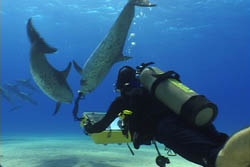
Tears, Hacking Cough, and Dead Fish on High End Real Estate
By Hardy Jones, executive director, BlueVoice.org
Deborah Cutting, shooting stills, and myself on video got out of our car at the site of an unusual (for this part of Florida) fish die-off and red tide event. Immediately our eyes began to burn and we started coughing. I’d heard about these occurrences of respiratory and eye irritation on the Gulf coast of Florida and along the central coast of California but never had the experience myself. It’s really odd to know that a toxin generated by a marine algae is blowing off the water with enough strength to cause respiratory distress in people walking the beaches and living nearby. I still have a scratchy throat hours after leaving the site.
See my blog of August 14, Algae Blooms Threatens Florida’s Gulf Coast for further information.
Some city employees tried to prevent me from filming the effects of this Harmful Algal Bloom (HAB) at Houguenot Memorial Park, a beach east of Jacksonville, Florida. That’s a bit bizarre until you realize that attractive beaches constitute much of the life blood of Florida. It reminds me of the town officials who tried to keep shark warnings from being posted in the film “Jaws” so as not to discourage tourists.
The fish at the high water mark were a sad sight. A blown up puffer fish, a needle-fish, mullet, even a baby alligator - How could that be? – all strewn, wide-eyed, mouths agape, like rubbish in a huge crescent at the top of the beach.
We drove north to Fernandina Beach that had been the scene of a similar event yesterday. But there were few dead fish. What was clearly visible were the scraping marks of the earth moving equipment that had just cleaned the beach of the dead fish, though not their odor still hung in the air.
First indication of the red tide had come from a NOAA satellite that detected it September 25. Northeasterly winds are moving the algal bloom south. In a day or so we may not have to travel more than a mile to see the bloom. It could reach St. Augustine that soon.
What has caused this bloom? Well, no one knows the specifics of this one. Experts at the Nassau County Department of Health say correctly that it’s a combination of water temperature, salinity and wind direction. But it’s more than that. These blooms are hugely exaggerated by fertilizers that run off agricultural land carrying nutrients that magnify the bloom. Combine a little global warming and you can get a super-bloom.
Florida real estate values already suffer from the declining national market, fear of hurricanes and rising insurance costs. You can add the threat of algal blooms which make a day at the beach a tearful event.
BTW, these HABs are a global phenomenon, growing more serious with each year.
UPDATE: By Friday, September 28 the red tide had crossed the St. John's County border and continues south.

